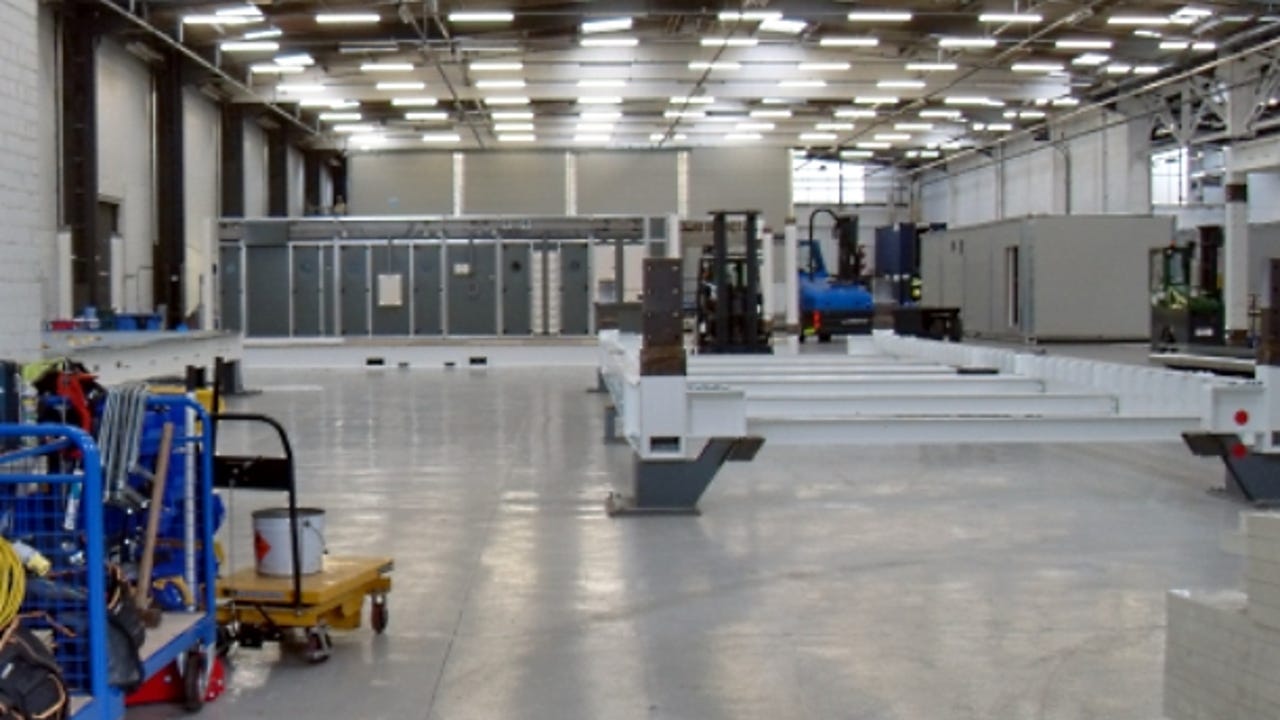Inside a datacentre factory


BladeRoom datacentre
BladeRoom has been in the business of building and selling datacentres for four years, putting to work its expertise gained over 20 years of making self-contained facilities for the healthcare and food sectors. Its containers have helped Capgemini achieve a high level of efficiency with its Merlin datacentre, located in Swindon.
In March, when ZDNet UK visited the factory — located in Mitcheldean, Gloucestershire — BladeRoom was in the process of assembling modules for datacentres for Australian distributor Metronode. The six facilities, which have a combined 22,000 square feet of space, will be set up in Perth, Melbourne and Sydney.
To get an idea of the design process, ZDNet UK followed the path that components take through the factory as they are assembled. The first stage is the assembly of the floor (right) and ceiling (far left) of each module.
It takes one day for the floor section of a module to be mated with the ceiling module via struts and to have its floor panelled with wood, according to Barnaby Smith, BladeRoom's head of communications.
See more of the datacentre tour on ZDNet UK.
BladeRoom modules PUE
Once the floor and ceiling have been combined (pictured, left), the module is panelled (right) and then modified internally to conform to the design specifications of the buyer.
Installed BladeRoom modules are all currently reporting power usage effectiveness ratings of between 1.13 and 1.34, the company said. Power usage effectiveness (PUE) expresses the amount of power expended on non-IT services for a datacentre, so a PUE of 1.13 indicates that for every unit of power spent on the servers and IT hardware, an additional .13 units are spent on the cooling, lighting and other supporting infrastructure.
BladeRoom said a datacentre built with its technology can typically be shipped and installed to the client's site 18 weeks after commissioning. That compares with an industry average of around 78 weeks, it said.
The company draws on its history of making modular kitchen facilities for events, and orthopaedic operating theatres and clean rooms for temporary deployment, to speed the time it takes to make the modules. "Everything is as slick as possible, like Meccano," Smith said.
See more of the datacentre tour on ZDNet UK.
BladeRoom UK manufacturers
To make efficient use of space while building out the inner electronics and cabling of a module, BladeRoom sometimes stacks two modules on top of one another (pictured).
The module's innards are fitted with fire suppression systems, wiring, buses and lighting.
The Forest of Dean factory puts the modules together from a range of pre-built components, supplied by around 20 companies. According to BladeRoom, 80 percent of the materials that come to the factory are sourced from UK manufacturers.
See more of the datacentre tour on ZDNet UK.
Overhead cabling system
"We're not reinventing the wheel; we're just using a lot of 'best practice' ideas," Smith said. These ideas are based around just-in-time manufacture of modules, testing and simplification of the build-out and installation process, he added.
One example is the use of an overhead cabling system, which reduces the complexity of the cooling of a module and eases the teardown and buildup of module segments. The technique used by BladeRoom is increasingly becoming adopted by datacentre owners. In April, Cisco gave details of a new, green datacentre that uses an overhead cabling system, for example.
"There is an argument in the industry that implementing a computer-accessed floor in this day and age is non-environmentally friendly," James Cribari, director of Cisco's global datacentre program, told ZDNet UK at the time.
See more of the datacentre tour on ZDNet UK.
Final module stage
One of the final stages a module goes through before being shipped to the customer is to have its airflow and electrical systems tested.
Power, fire suppression, the bus and other electronic control systems are all amalgamated through the central overhead cable basket (pictured), which runs the length of each module.
The basket makes it easier to fit everything at the end location and increases the ease of general purpose maintenance. It also eliminates the complications of having two competing areas of airflow, which is what happens when the main room is partitioned away from the underground area.
As far as design methodology goes, BladeRoom feels its approach is closest to that of Colt. Both companies develop modular datacentre systems that can be put together, then broken down and easily re-assembled, Smith said.
See more of the datacentre tour on ZDNet UK.
BladeRoom workers
Around 60 people work for BladeRoom, with 20 directly involved in the assembly and delivery of the datacentre modules.
See more of the datacentre tour on ZDNet UK.
BladeRoom module types
BladeRoom's datacentres are all designed to be broken down into individual pre-engineered modular components. These modules come in three varieties: air optimiser, IT module and power management.
They can be trucked down the motorway and loaded onto ships for international delivery. BladeRoom is using this method to transport the Australian-bound Metronode modules (pictured).
See more of the datacentre tour on ZDNet UK.